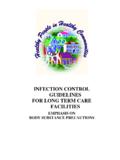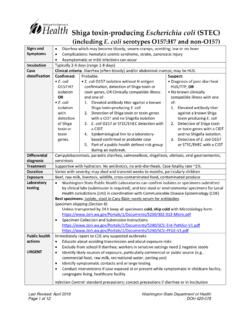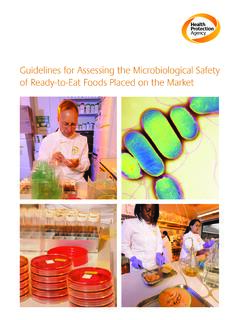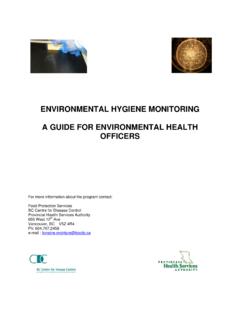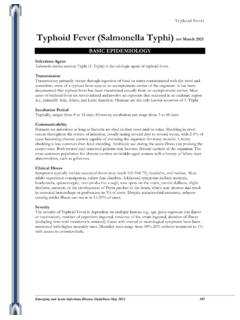Transcription of Foodborne disease outbreaks: Guidelines for investigation ...
1 Foodborne disease outbreaks: Guidelines for investigation and control WHO Library Cataloguing-in-Publication Data Foodborne disease outbreaks : Guidelines for investigation and control. contamination - prevention and control. poisoning - prevention and control diseases - prevention and control. diseases - epidemiology. infections - prevention and control infections - epidemiology. outbreaks. Health Organization. ISBN 978 92 4 154722 2 (NLM classification: WC 260). World Health Organization 2008. All rights reserved. Publications of the World Health Organization can be obtained from WHO Press, World Health Organization, 20 Avenue Appia, 1211 Geneva 27, Switzerland (tel.: +41 22 791 3264;. fax: +41 22 791 4857; e-mail: Requests for permission to reproduce or translate WHO publications whether for sale or for noncommercial distribution should be addressed to WHO.)
2 Press, at the above address (fax: +41 22 791 4806; e-mail: The designations employed and the presentation of the material in this publication do not imply the expression of any opinion whatsoever on the part of the World Health Organization concerning the legal status of any country, territory, city or area or of its authorities, or concerning the delimitation of its frontiers or boundaries. Dotted lines on maps represent approximate border lines for which there may not yet be full agreement. The mention of specific companies or of certain manufacturers' products does not imply that they are endorsed or recommended by the World Health Organization in preference to others of a similar nature that are not mentioned. Errors and omissions excepted, the names of proprietary products are distinguished by initial capital letters.)
3 All reasonable precautions have been taken by the World Health Organization to verify the information contained in this publication. However, the published material is being distributed without warranty of any kind, either expressed or implied. The responsibility for the interpretation and use of the material lies with the reader. In no event shall the World Health Organization be liable for damages arising from its use. Printed in France Contents Acknowledgements iii Foreword v Introduction 1. Section 1. Practical guide 2. Section 2. Planning and preparation 4. General 4. outbreak control team 4. Record keeping 6. Communication 6. Section 3. Surveillance to detect Foodborne disease outbreaks 9. Introduction 9. Definitions 9.
4 Data sources 9. Interpreting data sources 12. Section 4. investigation of Foodborne disease outbreaks 14. General 14. Epidemiological investigations 14. Environmental and food investigations 36. Laboratory investigations 43. Section 5. Control measures 47. General 47. Control of source 47. Control of transmission 50. End of outbreak 52. Section 6. Features of important Foodborne diseases 54. Foodborne pathogens, toxins and chemicals of public health importance 54. Major Foodborne pathogens: predominant clinical features 56. Major Foodborne diseases: epidemiology and methods of control and prevention 61. References 94. Further reading 96. Annexes 1. Glossary 98. 2. outbreak control meeting: draft agenda 103. 3. Examples of outbreak investigation forms 104.
5 4. Questionnaire design 107. 5. Sample questionnaires 109. 6. investigation report forms 114. 7. Statistics 127. 8. Situations likely to contribute to Foodborne disease outbreaks 132. 9. Procedures and equipment for specimen collection 139. 10. The WHO Five Keys to Safer Food 146. Foodborne disease Outbreaks: Guidelines for investigation and Control i ii Foodborne disease Outbreaks: Guidelines for investigation and Control Acknowledgements The World Health Organization (WHO) would like to pay a special tribute to one of the reviewers of this manual, Aileen Plant, who passed away on 27 March 2007. Aileen Plant was a renowned medical epidemiologist, an outstanding global public health leader, and a long-standing friend to the public health community.
6 She was a respected lecturer, teacher and writer and made enormous contributions to the health and welfare of people around the world. Aileen Plant was at the coal face of investigating many outbreaks, including the early outbreaks of severe acute respiratory syndrome (SARS) in Viet Nam. She will be sorely missed. This manual is dedicated to her memory. WHO would also like to express its sincere appreciation to the authors and other reviewers of this manual, including: Frederick Angulo, Centers for disease Control and Prevention, Atlanta, GA, USA; Mary Beers, Australian Field Epidemiology Training Programme, National Institute of Epidemiology, Canberra, Australia; Sarah Cahill, Nutrition Officer (Food Microbiology), Food Quality and Standards Service, Food and Agriculture Organization of the United Nations (FAO), Rome, Italy; John Cowden, Scottish Centre for Infection and Environmental Health, Glasgow, Scotland; Harold Davis, United States Department of Agriculture, Food Safety and Inspection Services, Washington DC, USA.
7 Jean Claude Desenclos, D partement des maladies infectieuses, Institut de veille sanitaire, Paris, France; Leslie Edwards, Maryland Department of Health, Baltimore, MD, USA; Ruth Etzel, United States Department of Agriculture, Food Safety and Inspection Services, Washington DC, USA; Eleni Galanis, British Columbia Centre for disease Control, Vancouver, BC, Canada; Timothy Jones, Tennessee Department of Health, Nashville, TN, USA; Michael Lynch, Centers for disease Control and Prevention, Atlanta, GA, USA; Ruthanne Marcus, Emerging Infections Program, Yale University, New Haven, CT, USA; Noel McCarthy, Food Safety Authority of Ireland, Dublin, Ireland; Robert Mitchell, Public Health Laboratory Service, Environmental Surveillance Unit, London, England; Jocelyne Rocourt, Institut Pasteur, Yaound , Cameroon.
8 Jeanette Stehr-Green, Public Health Foundation, Port Angeles, WA, USA; Patrick Wall, Food Safety Authority of Ireland, Dublin, Ireland. Thanks are also due to the following WHO staff members, who reviewed the draft document: Margaret Miller, Enrique P rez Guti rrez, Bruce Plotkin, and Joanna Tempowski. The preparation of this document was coordinated by the following WHO staff members: Peter Karim Ben Embarek, Peter Braam, Andrea Ellis, Thomas Grein, Marco Jermini, Yasmine Motarjemi, Jenny Murcott, J rgen Schlundt, Claudia Stein and Hajime Toyofuku. Foodborne disease Outbreaks: Guidelines for investigation and Control iii iv Foodborne disease Outbreaks: Guidelines for investigation and Control Foreword Acute diarrhoeal illness is very common worldwide and estimated to account for million childhood deaths annually, predominantly in developing countries (World Health Organization, 2005).
9 The burden of diarrhoeal illness is substantial in developed countries as well (Scallan et al., 2005). Estimates of the burden of Foodborne diseases are complicated by a number of factors: different definitions of acute diarrhoeal illness are used in various studies, most diarrhoeal illness is not reported to public health authorities, and few illnesses can be definitively linked to food. While not all gastroenteritis is Foodborne , and not all Foodborne diseases cause gastroenteritis, food does represent an important vehicle for pathogens of substantial public health significance. A number of studies are under way that aim to provide a better understanding of the global public health burden of gastroenteritis and Foodborne diseases (Flint et al.)
10 , 2005). There are many reasons for Foodborne disease remaining a global public health challenge. As some diseases are controlled, others emerge as new threats. The proportions of the population who are elderly, immunosuppressed or otherwise disproportionately susceptible to severe outcomes from Foodborne diseases are growing in many countries. Globalization of the food supply has led to the rapid and widespread international distribution of foods. Pathogens can be inadvertently introduced into new geographical areas, such as with the discharge of ballast water contaminated with Vibrio cholerae in the Americas in 1991. Travellers, refugees and immigrants may be exposed to unfamiliar Foodborne hazards in new environments.










